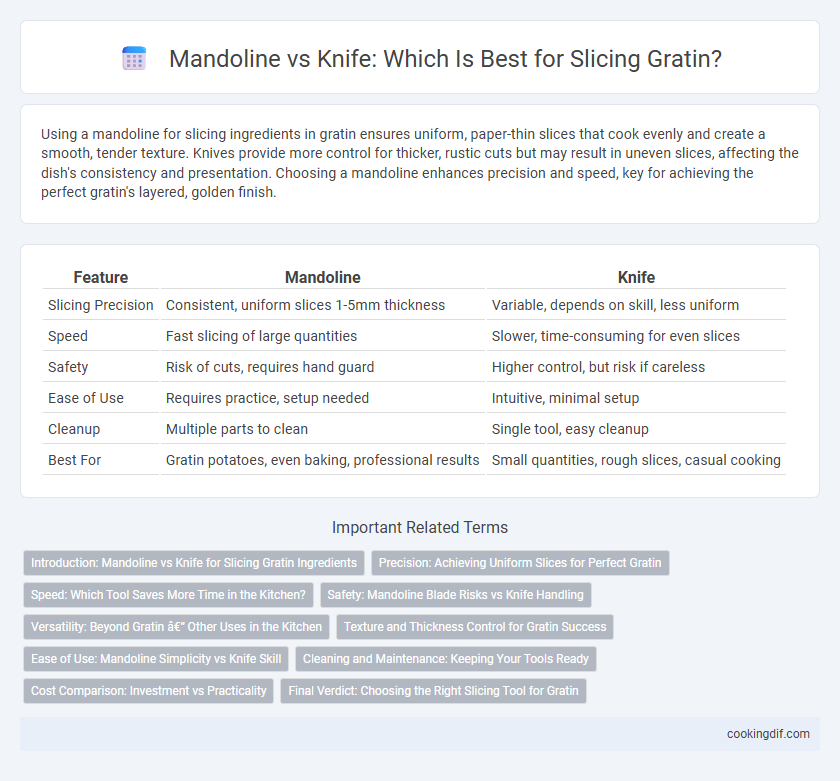Using a mandoline for slicing ingredients in gratin ensures uniform, paper-thin slices that cook evenly and create a smooth, tender texture. Knives provide more control for thicker, rustic cuts but may result in uneven slices, affecting the dish's consistency and presentation. Choosing a mandoline enhances precision and speed, key for achieving the perfect gratin's layered, golden finish.
Table of Comparison
| Feature | Mandoline | Knife |
|---|---|---|
| Slicing Precision | Consistent, uniform slices 1-5mm thickness | Variable, depends on skill, less uniform |
| Speed | Fast slicing of large quantities | Slower, time-consuming for even slices |
| Safety | Risk of cuts, requires hand guard | Higher control, but risk if careless |
| Ease of Use | Requires practice, setup needed | Intuitive, minimal setup |
| Cleanup | Multiple parts to clean | Single tool, easy cleanup |
| Best For | Gratin potatoes, even baking, professional results | Small quantities, rough slices, casual cooking |
Introduction: Mandoline vs Knife for Slicing Gratin Ingredients
A mandoline offers precise, uniform slices essential for evenly cooked gratin layers, enhancing texture and presentation. Knives provide more control for irregular or thicker slicing but require skill to maintain consistent thickness. For optimal gratin results, mandolines improve efficiency and reduce preparation time while ensuring consistent baking.
Precision: Achieving Uniform Slices for Perfect Gratin
Using a mandoline for slicing ensures consistent, uniform thickness essential for evenly cooked gratin layers, enhancing both texture and appearance. Precision-cut slices facilitate even heat distribution, preventing undercooked or burnt edges common with irregular knife cuts. While a sharp knife allows control, the mandoline's adjustable settings provide unparalleled accuracy for perfect gratin preparation.
Speed: Which Tool Saves More Time in the Kitchen?
Using a mandoline for grating slices significantly saves time compared to a knife, as its sharp, adjustable blades quickly create uniform slices with minimal effort. Professional chefs often choose mandolines to boost kitchen efficiency, slicing dozens of potatoes in minutes, whereas knives require more precision and can slow down the process. This speed advantage directly reduces prep time, making the mandoline ideal for quick gratin preparation.
Safety: Mandoline Blade Risks vs Knife Handling
Using a mandoline for gratin slicing offers uniform, paper-thin slices but comes with significant blade risks, including severe cuts due to its exposed, sharp edge. Knives provide greater control and reduce injury hazards when handled properly, especially with techniques like the claw grip to protect fingers. Prioritizing safety, many cooks opt for a high-quality chef's knife over a mandoline to minimize the risk of accidents during food preparation.
Versatility: Beyond Gratin – Other Uses in the Kitchen
A mandoline offers exceptional versatility beyond gratin preparation, enabling uniform slicing of vegetables like potatoes, cucumbers, and carrots for salads, chips, and stir-fries with consistent thickness. While a sharp kitchen knife allows more control for intricate cuts and uneven textures, the mandoline enhances efficiency and precision for bulk slicing tasks across various recipes. Chefs often prefer mandolines for their adjustable blades and safety features, making them indispensable tools in both professional and home kitchens for diverse culinary applications.
Texture and Thickness Control for Gratin Success
Using a mandoline for slicing gratin ingredients ensures uniform thickness, which is essential for even cooking and consistent texture throughout the dish. A sharp knife allows more flexibility but often results in uneven slices, leading to varied cooking times and potentially inconsistent textures. Precise thickness control achieved with a mandoline helps create a perfectly tender and cohesive gratin with a smooth, creamy interior and a crisp, golden top.
Ease of Use: Mandoline Simplicity vs Knife Skill
A mandoline ensures uniform gratin slices with minimal effort, making it ideal for consistent thickness and even cooking. Using a knife requires advanced slicing skills and steady control to achieve similar precision. For ease of use, the mandoline significantly reduces preparation time and the risk of uneven cuts compared to manual knife slicing.
Cleaning and Maintenance: Keeping Your Tools Ready
Mandolines offer uniform slices with minimal effort but require thorough cleaning to remove food debris trapped between blades and guards. Knives are easier to clean quickly, with straightforward rinsing and wiping, reducing the risk of residue buildup. Proper maintenance of both tools, including drying and occasional sharpening for knives or blade care for mandolines, ensures optimal performance and longevity.
Cost Comparison: Investment vs Practicality
A mandoline offers precise, uniform slices essential for gratin dishes, but its initial cost can be higher compared to a basic kitchen knife. Knives are more affordable and versatile, yet require advanced skill for consistent thin slicing. Investing in a mandoline balances practicality with efficiency, reducing prep time and enhancing the gratin's presentation despite the upfront expense.
Final Verdict: Choosing the Right Slicing Tool for Gratin
For achieving perfectly uniform slices in gratin, a mandoline excels by delivering consistent thickness essential for even cooking and presentation. Knives offer greater control and flexibility but require skill to maintain uniformity, which can affect the dish's texture and doneness. Choosing between a mandoline and a knife depends on the user's confidence in knife skills and the desired precision, with the mandoline being ideal for precision and efficiency in gratin preparation.
Mandoline vs Knife for slicing Infographic

 cookingdif.com
cookingdif.com